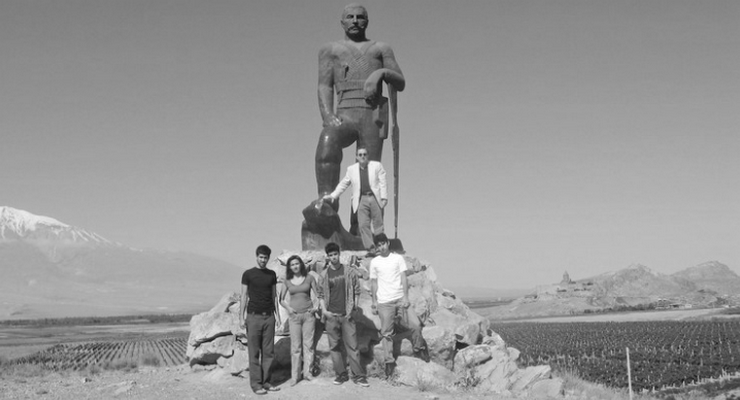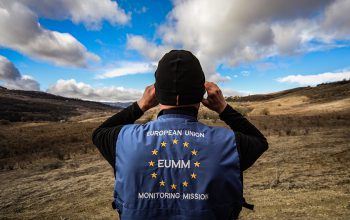Caption for image above: Author Bill Paparian stands at the foot of the statue of Armenian Fedayee Gevorg Chavush, Below him from left to right his son Aram, wife Sona, son Saro, and son Nishan. Mt. Ararat towers in the background at the left. [Courtesy photo]
On Father’s Day 2007, 100 years after Nishan Paparian of Kharpet in Turkish-occupied Armenia arrived at Ellis Island, his descendants returned to Armenia. It is a trip that we had talked about doing for years, we finally made the pilgrimage home.
It was a long flight for our family from Los Angeles to Yerevan with a stopover in Munich, Germany. When we arrived at Zvartnots airport we were taken by shuttle bus from our Lufthansa flight to an impressive terminal building.
We had arranged for an apartment flat conveniently located on Tumanian Street near Mesrop Mastots Avenue. The apartment was on the second floor of an older renovated building and had a large balcony from which we could observe life on the street below us.
The unbridled energy and excitement of life in Yerevan is palpable. The indomitable spirit of the Armenian people is manifested in the daily lives of the citizens of Armenia! We enjoyed our early morning walks and on one such excursion discovered a historic building that is unmarked on any tourist map or mentioned in any tour guidebook. It is the home of Aram Manougian, the first President of the Republic of Armenia.
Our visit to Tsitsernakaberd and the Genocide Memorial and Museum led to a poignant afternoon of reflection and remembrance.
The real story of our pilgrimage home began as we made our day trips out of the capital city that began with our visit to beautiful Lake Sevan. As we strolled along the shore and waded in the cool waters we felt as if we had finally arrived in our ancestral homeland. We climbed Sevan Peninsula to the top of the hill where the Sevanavank Monastery is located. Then we traveled further north to the lush forests of Dilijan.
We ended up at a roadside café, sat above a streaming mountain creek and had a marvelous lunch of mouth-watering shish kabob and enjoyed the locally bottled mineral water.
The following day we visited the pagan temple at Garni with the breathtaking view of the deep canyon below.
On the road to Sardarapat, we discovered a monument to the defenders of Musa Dagh that is not mentioned in any guidebooks or tourist maps.
As we climbed the steps at Sardarapat leading up to the winged lions, the bells in the tower started ringing. As we made our return to Yerevan, we stopped at Echmiadzin and spent several hours there. We lit candles in the cathedral and saw the old pagan altar over which the cathedral had originally been built. We also visited the Zvartnots Cathedral.
On the final day of our pilgrimage, we got as close as we could to Mt. Ararat in the village of Lusarat. Driving through the center of town, we were amazed to see Groongs gazing hauntingly down on us as they perched nobly atop tall poles along the road.
We could not go far past the village because we encountered a military watch tower guarded by Russian soldiers, one of the many guard posts alongside the Arax River which serves as the international boundary that separated us from Turkish occupied Armenia.
As we headed toward the nearby monastery at Khor Virap, we stopped at a small hill where there is a heroic statue of Armenian Fedayee Gevorg Chavush.
We climbed the hill and had a family picture taken there.
I sat on a rock behind the statue and as I gazed out upon Mt. Ararat absorbing its power and majesty, I thought of those Groongs down below me and the immortal words of Hovhannes Toumanian in his poem “The Crane.”
In the shadow of a monument to an Armenian Freedom Fighter, I was sitting on Armenian soil looking out across the Ararat valley below me. On the other side of that legendary mountain is the land of my forefathers. We had come home and yet we were not completely home.
One hundred years after Nishan Paparian left our homeland, his grandson and great-grandsons have kept the faith. One Armenian family has triumphed against the Turkish government’s attempt to extinguish the burning flame of our identity as a race. But like the crane in Toumanian’s poem our journey home is not yet over:
“The Crane has lost his way across the heaven,
From yonder stormy cloud I hear him cry,
A traveller o’er an unknown pathway driven,
In a cold world unheeded he doth fly.
Ah, whither leads this pathway long and dark,
My God, where ends it, thus with fears obsessed?
When shall night end this day’s last glimmering spark?
Where shall my weary feet to-night find rest?
Farewell, belovèd bird, where’er thou roam
Spring shall return and bring thee back once more,
With thy sweet mate and young ones, to thy home–
Thy last year’s nest upon the sycamore.
But I am exiled from my ruined nest,
And roam with faltering steps from hill to hill,
Like to the fowls of heaven in my unrest
Envying the boulders motionless and still.”
Each boulder unassailed stands in its place,
But I from mine must wander tempest tossed–
And every bird its homeward way can trace,
But I must roam in darkness, lone and lost.
Ah, whither leads this pathway long and dark,
My God, where ends it, thus with fears obsessed?
When shall night end this day’s last glimmering spark?
Where shall my weary feet to-night find rest?”
Bill Paparian is a former Pasadena mayor




